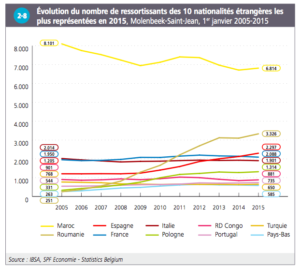A portrait of Molenbeek
What is your view of Molenbeek?: “Molenbeek, a beautiful example of diversity, conviviality and living together. It will resist all storms. As people say: ‘If you break tree trunks, they will grow back at the root’. Molenbeek is like that, says Malika El Malik.
Since Molenbeek was put on the map at the international level in November 2015 by the aprehension of terror suspect Salah Abdeslam, many social and cultural initiatives have sprung up, alongside projects to stimulate job creation and creativity and the urban renewal of the Rive Gauche of Brussels.
While the nature of these projects and target audiences differ, what unites most of them is an attempt to reflect the diversity of a municipality, in which 28% of the population is foreign. They seek to create connections between the inhabitants of Molenbeek, as well as with those coming from the other 18 municipalities of the Brussels Capital Region.

These project’s funding comes through public and private financing, at both local and regional level. Some of the funding began already before 2015, while some has been subsequently given. In any case, a little over two years after its international exposure, the social, cultural, economic and urbanistic reality of Molenbeek is constantly undergoing change.
Just last week, the platform MolenGeek was recognized as 2017 ‘Bruxellois’ of the year, in the economic category. Launched in 2015, as a project incubator and training centre for digital technologies, it offers realistic hope for the neighbourhood’s youth.
The European Institutions have also sought to involve Molenbeek in some of their actions. For example, the Spanish writer and journalist Jordi Sebastià, in his role as former MEP, has organized poetry readings on a number of occasions in honour of the Valencian poet Vicent Andrés Estellés. The idea is to bring the work of a working-class poet to a working-class neighbourhood.

The concert-hall VK and its roster of international artists boosts the arrival of non-locals to Comte de Flandre, as does the weekly organic market, which takes place every Wednesday. Found in Molenbeek, an organisation started by a local collective of advertisers, uncovers unknown places in the municipality, in order to counter its negative image in the media.
In the Quai des Charbonnages, a giant sailboat seems to plough through the waters of the canal. Meanwhile, Le Phare du Kanaal, resembles a lighthouse. In 2015, Hanna Bonnier, founder and proprietor, set up this meeting space between entrepreneurs and freelancers from all over Europe. It helps to promote diversity and European identity and has become a key player in Molenbeek, through its collaborations with local organisations such as the Maison des Cultures et de la Cohésion Sociale.
Not far from Le Phare, in Molenbeek’s main square, Brass’Art Digitaal Café was inaugurated last year, as a café and urban artistic laboratory. In the Quartier Maritime, after leaving behind the area known as historic Molenbeek, is the Centre Communautaire Maritime, housed in an old L’Oréal factory, opposite one belonging to the Bacardi-Martini group. It plays host to the second edition of the film festival Molen Zinnema, designed to help local residents discover hidden corners of their streets through the art of cinema.
Molenbeek’s profile – Institut Bruxellois de Statistique et d’Analyse (IBSA)
- 95.576 inhabitants
- 5,9 km2 (4% of the territory of Brussels-Capital Region)
- More than a quarter of the population is under 18 and the average age is 35. Molenbeek is thus one of the youngest municipalities in the Brussels Capital Region.
- 28% of the population is of foreign nationality
- Morrocan citizens make up the majority of the populations followed by Romanians. Slightly less than a third are from EU 15 countries
- It is one of the poorest municipalities in the region. Many inhabitants are on low income or receive financial support
- The employment rate is lower than the regional average, particularly for women.
- 62% of the 60,060 people of working age (15-64 years) are active in the labour market in Molenbeek



